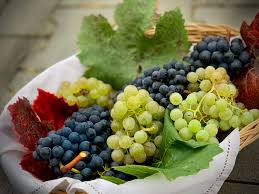Grapes are small, round fruits that come in various colors like red, green, and purple. These delightful little fruits grow in clusters on vines and are enjoyed by people all around the world.
One remarkable thing about grapes is their sweet and juicy taste. When you bite into a grape, you experience a burst of flavor that can be both refreshing and satisfying. This natural sweetness makes grapes a popular choice for snacks, desserts, and even in making juices and wines.
The versatility of grapes is truly impressive. Whether eaten fresh, dried into raisins, or pressed into wine, grapes offer a range of culinary possibilities. In fact, grapes have been cultivated for thousands of years, and their importance in various cultures is evident in both ancient and modern times.
The health benefits of grapes are another reason to appreciate these tiny fruits. Packed with vitamins and antioxidants, grapes contribute to overall well-being. They are known to support heart health, boost the immune system, and provide a quick energy boost. Additionally, the skin of grapes contains resveratrol, a compound believed to have potential health-promoting properties.
Grapes also play a significant role in cultural symbolism. In some traditions, grapes symbolize abundance and prosperity. In others, they are associated with celebrations and joy, often featuring prominently in festive occasions and rituals.
The cultivation of grapes involves careful attention to the vineyards. Grapevines require suitable climates, proper soil conditions, and adequate care to thrive. The process of growing grapes, from planting to harvesting, is a fascinating journey that involves the collaboration of nature and human expertise.
As grapes ripen on the vine, they undergo changes in color and flavor, reflecting the unique characteristics of different grape varieties. From the crispness of green grapes to the rich sweetness of red and purple varieties, each type offers a distinct tasting experience.
Whether enjoyed alone as a snack, paired with cheese, or transformed into a fine wine, grapes have an enduring appeal that transcends culinary preferences. Their contribution to the world of gastronomy, health, and cultural traditions makes grapes a truly remarkable fruit that continues to captivate people of all ages.
In addition to their delicious taste and nutritional benefits, grapes have also become a focal point of agricultural practices. Grape cultivation involves careful attention to the seasons, with farmers monitoring the vines throughout the year. Pruning, training, and pest control are essential aspects of grapevine management, ensuring a bountiful harvest.
The process of turning grapes into wine is a time-honored tradition that has been refined over centuries. Grapes are carefully selected, crushed, and fermented to create the diverse array of wines enjoyed globally. Each wine variety carries the unique essence of the grape it originates from, reflecting the terroir—the combination of soil, climate, and cultivation practices.
Grapes have found their way into countless recipes, adding a touch of sweetness and complexity to both savory and sweet dishes. From grape salads to grape tarts, the culinary world continues to experiment with these versatile fruits, showcasing their ability to enhance a wide range of flavors.
Beyond their culinary and agricultural significance, grapes hold cultural importance in various societies. In some traditions, grapes are a symbol of fertility and prosperity. They are often featured in religious ceremonies, symbolizing abundance and the sweetness of life. In others, grapes are central to celebrations, such as the famous grape harvest festivals that take place in different parts of the world.
Grapes have also inspired art and literature throughout history. Their vibrant colors, unique shapes, and association with pleasure have made them a muse for artists and writers alike. Whether depicted in paintings, mentioned in poems, or celebrated in folklore, grapes continue to be woven into the fabric of human creativity.
On a more practical note, the health benefits of grapes have been a subject of scientific interest. Studies suggest that the antioxidants present in grapes may have positive effects on cardiovascular health, helping to lower blood pressure and reduce the risk of heart disease. Additionally, the polyphenols in grapes may contribute to anti-inflammatory and anti-cancer properties, adding to their overall appeal as a healthful fruit.
However, grapes are not just ordinary fruits; they are a tapestry of flavor, culture, and well-being. From their humble beginnings on the vine to their transformation into culinary delights and fine wines, grapes continue to enchant and nourish. So, the next time you enjoy a handful of grapes or savor a glass of wine, remember the rich history and diverse journey of this small but extraordinary fruit.
Read Also: 15 Medicinal Health Benefits Of Palm Tree
How to Grow and Care for Grapes

Here is a simple guide to growing and caring for grapes:
1. Planting: Grapes thrive in well-drained soil and sunny locations. Choose a site with good air circulation to prevent diseases. Plant grapevines in early spring or late fall, spacing them about 8 feet apart. Dig a hole deep enough to accommodate the roots and water the plant thoroughly after planting.
2. Soil Requirements: Grapes prefer slightly acidic to neutral soil with a pH range of 6.0 to 6.5. Ensure good drainage to prevent waterlogged roots. Amending the soil with organic matter can enhance fertility and structure.
3. Watering: Grapes need regular watering, especially during dry periods. Provide about 1 inch of water per week, adjusting based on weather conditions. Be cautious not to overwater, as grapevines are susceptible to root rot.
4. Pruning: Pruning is crucial for grapevines to encourage air circulation, reduce disease risk, and promote better fruit production. Prune during the dormant season, removing old and weak wood. Training the vines along a trellis or support system helps manage growth and facilitates harvesting.
5. Fertilization: Apply a balanced fertilizer in early spring to promote healthy growth. Too much nitrogen can lead to excessive foliage at the expense of fruit production, so choose a fertilizer with a balanced N-P-K ratio.
6. Pest and Disease Control: Keep an eye out for common pests like aphids and mites. Applying insecticidal soap or neem oil can help control infestations. Additionally, fungal diseases such as powdery mildew and downy mildew can affect grapevines. Use fungicides as needed, and practice good garden hygiene by removing fallen leaves.
7. Harvesting: Grapes are typically ready for harvest in late summer to early fall, depending on the variety. Harvest when the grapes are fully colored and have a slightly soft feel. Cut the clusters with clean, sharp shears, leaving a small stem attached.
8. Wine Varieties vs. Table Varieties: If cultivating grapes for winemaking, choose wine grape varieties suitable for your climate. For table grapes, consider popular varieties like Thompson Seedless, Concord, or Red Flame.
9. Overwintering: Protect grapevines from winter cold by mulching around the base. In colder climates, consider covering the vines with burlap or other protective material.
10. Training on Trellis: Use a trellis system to train grapevines for better sun exposure and air circulation. Common trellis types include the single curtain, high cordon, and T-shaped systems.
By following these guidelines, you can enjoy a successful grape harvest and perhaps even try your hand at making homemade grape products or wine. Happy growing!
Read Also: 15 Medicinal Health Benefits Of Calendula (Marigold)
Uses of Grapes

Below are the common uses of grapes:
1. Fresh Snacking: The simplest and most delightful way to enjoy grapes is by eating them fresh. Their natural sweetness and juiciness make them a perfect healthy snack.
2. Dried as Raisins: Grapes can be dried to make raisins. These sweet and chewy treats are excellent for snacking, baking, or adding to cereals and salads.
3. Juicing: Grapes, when juiced, create a refreshing beverage that is not only tasty but also rich in vitamins and antioxidants. Mix grape juice with other fruits for a flavorful blend.
4. Wine Production: Grapes are a key ingredient in winemaking. Different grape varieties contribute to the diverse flavors and characteristics found in various types of wines.
5. Cooking and Baking: Grapes can be incorporated into both savory and sweet dishes. They add a burst of flavor to salads, can be roasted with meats, or used in desserts like tarts and cakes.
6. Jams and Preserves: Make homemade grape jams, jellies, or preserves. These can be spread on toast, used as toppings for desserts, or even paired with cheese for a tasty combination.
7. Vinegar Production: Grapes can be fermented to create grape vinegar, a versatile condiment that adds depth of flavor to salads, marinades, and sauces.
8. Beauty Products: Grape seed oil, extracted from grape seeds, is used in skincare products due to its antioxidant properties. It moisturizes the skin and is often found in creams, lotions, and massage oils.
9. Medicinal Purposes: Grapes, especially dark-colored varieties, contain resveratrol, a compound believed to have health benefits. Some people consume grapes for potential cardiovascular and anti-aging effects.
10. Garnishes and Decorations: Use grapes as edible garnishes for cheese platters, desserts, or drinks. Their vibrant colors and appealing shapes can enhance the visual appeal of various dishes.
11. Grape Leaves in Cuisine: In certain cuisines, grape leaves are used to wrap and cook various dishes, such as dolma. These leaves impart a unique flavor to the food.
12. Vineyard Tourism: Beyond consumption, grape cultivation attracts tourists to vineyards. Visitors can experience the winemaking process, enjoy tastings, and explore the picturesque landscapes.
From simple snacking to complex winemaking, grapes offer a wide range of uses that cater to culinary, nutritional, and even aesthetic preferences. Their adaptability in various forms makes them a truly versatile and enjoyable fruit.
Economic Importance of Grapes

Grapes economic Importance includes:
1. Wine Industry: The wine industry is a major contributor to the global economy, and grapes are the primary raw material for wine production. Vineyards, wineries, distribution, and associated businesses create jobs and contribute significantly to regional and national economies.
2. Table Grape Market: The production and sale of table grapes for fresh consumption contribute substantially to the agricultural sector. This market is a significant source of income for grape growers and supports numerous jobs in harvesting, packing, and distribution.
3. Exports and Trade: Many countries engage in the export of grapes, both as fresh fruit and processed products like raisins or wine. This international trade contributes to foreign exchange earnings and strengthens economic ties between nations.
4. Tourism and Hospitality: Vineyard tourism, popular in wine-producing regions, boosts local economies. Tourists visit vineyards, participate in wine tastings, and stay in accommodations, generating revenue for the hospitality sector.
5. Employment Opportunities: Grape cultivation, from planting and tending to harvesting, requires a considerable workforce. The industry provides employment opportunities in rural areas, supporting livelihoods for farmworkers and those involved in the production chain.
6. Processing and Manufacturing: Beyond fresh consumption, grapes are processed into various products such as juices, jams, and raisins. The manufacturing sector involved in grape processing contributes to economic development and job creation.
7. Research and Innovation: The grape industry stimulates research in agriculture, viticulture, and oenology (the study of wine and winemaking). Innovations in grape cultivation, disease resistance, and winemaking techniques can enhance productivity and economic efficiency.
8. Health and Wellness Industry: Grapes are recognized for their health benefits, leading to the production of grape-based supplements, grape seed extracts, and skincare products. This diversification contributes to the wellness and beauty industry.
9. Agro-Tourism and Events: Grape-related festivals, events, and agro-tourism initiatives draw visitors and contribute to the local economy. These activities showcase the cultural and agricultural significance of grapes.
10. Infrastructure Development: The establishment and maintenance of vineyards and wineries often lead to infrastructure development in rural areas. This includes roads, utilities, and facilities that benefit both the grape industry and local communities.
11. Support Industries: The grape industry stimulates supporting sectors such as packaging, transportation, and marketing. These interconnected industries contribute to the overall economic ecosystem.
12. Sustainable Practices: As consumer demand for sustainable and organic products grows, grape growers adopting environmentally friendly practices can benefit economically. Certifications for organic and sustainable grape cultivation open up niche markets and may command premium prices.
The economic importance of grapes extends far beyond their culinary uses, shaping industries, supporting livelihoods, and influencing global trade dynamics. From local vineyards to international markets, grapes play a vital role in fostering economic growth and development.
Read Also: How to Control Pests in the Garden

